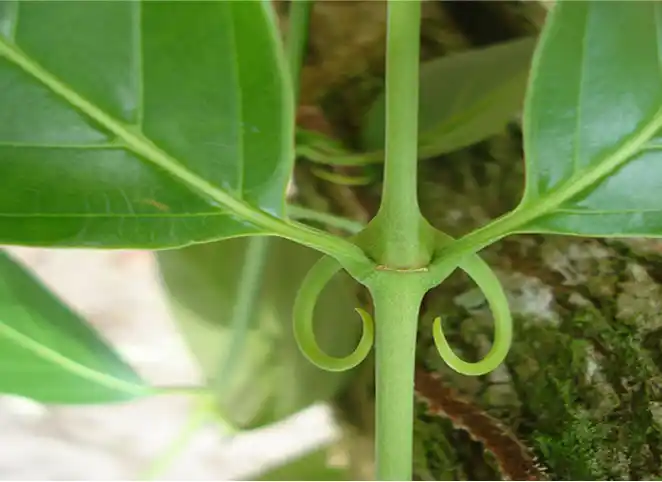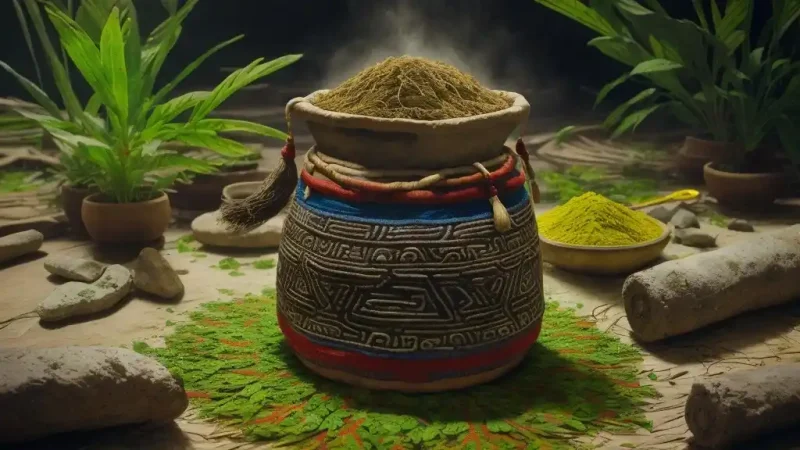What is Cat’s Claw?
Cat’s Claw, or Una de Gato (Latin: Uncaria tomentosa), is known as the “Amazon Wonder of Phytotherapy” and is among the most sought-after healing plants globally due to its curative effects. It serves as the most potent natural immune stimulant known to humans.
Native to the rainforests of Peru, Cat’s Claw is also found in other South American countries like Ecuador, Colombia, Brazil, and Venezuela. This incredible vine can reach heights of up to 20 meters and is named “Cat’s Claw” due to its stem’s hooked thorns, some of which can be up to 2 centimeters long.
Ancient Usage Traditions
Cat’s Claw usage dates back to the time of the Incas. Peruvian Inca priests considered it the “Fountain of Life” and used it for preventing various diseases.
Indigenous South American tribes have employed Cat’s Claw as a medicinal plant for over 2,000 years. Research has shown that these tribes remained healthy and disease-free, attributing their well-being to regular consumption of tea made from this vine’s bark.
The plant’s bark is actively used in folk medicine for treating abscesses, allergies, malignant tumors, rheumatism, arthritis, diabetes, liver cirrhosis, asthma, menstrual disorders, and a range of other conditions. [1]
Cat’s Claw and Its Medicinal Use
Recognition by the World Health Organization (WHO)
In 1994, the WHO hosted the first international conference on Cat’s Claw in Geneva, recognizing its significance. No other plant from the Amazon rainforest has garnered as much interest in the international scientific community since the discovery of quinine.
Its alkaloids, at least six of which have been proven to increase immunity by up to 50 percent, have piqued the interest of the international scientific community. Clinical confirmation exists for five alkaloids in their efficacy against leukemia, tumors, ulcers, infections, and arthritis. [2]
Impressive Results from Scientific Studies on Cat’s Claw’s Immunity Effects
Scientific studies have shown that Cat’s Claw has a strong impact on the immune system and can be useful in treating various diseases.
Studies have revealed that Cat’s Claw has anti-inflammatory properties, reducing inflammation by 46-89%. This makes it a valuable tool in combating diseases like arthritis and rheumatism. [3, 4]
One of the most notable discoveries concerns its potential cancer-inhibiting properties. Italian researchers have demonstrated a 90% inhibition of breast cancer cell growth in in vitro studies. Multiple studies have confirmed this and also found it can inhibit the growth of cells in lymphomas, leukemia, cervical cancer, osteosarcoma, and melanoma (skin cancer). [5-9]
Furthermore, Cat’s Claw extract increases the white blood cell count in healthy individuals by up to 8.8% after six weeks of treatment. [10] This demonstrates its capacity to support a healthy immune system. Another study showed an average 35% increase in the percentage of lymphocytes in HIV-infected individuals. [11]
Cat’s Claw extract is utilized to alleviate the side effects of chemotherapy and radiation therapies. Numerous studies have shown patients experiencing significant reductions in side effects such as hair and weight loss, nausea, secondary infections, and skin problems. [12, 13]
Thus, Cat’s Claw not only enhances the immunity of healthy individuals but also aids those dealing with serious illnesses like cancer and HIV.
Proven health benefits of Cat’s Claw, supported by scientific studies, include:
1. Combating bacteria, viruses, fungi, and parasites. It assists in combating a range of bacteria such as Enterobacteriaceae, Streptococcus, and Staphylococcus aureus, respiratory viruses including Covid-19, and a wide array of fungi and parasites. [4, 14]
2. Heart and vascular protection. Cat’s Claw improves the cardiovascular system by lowering blood pressure, regulating heart rhythm, and enhancing circulation. [4]
3. Anti-inflammatory properties. It reduces inflammation and aids in pain relief and diseases associated with inflammation.
4. Anti-cancer. Studies have shown its ability to inhibit cancer cell growth and possess anticancer effects.
5. Immune system support. Cat’s Claw strengthens the immune defense and shields the body against infections.
6. Nervous system enhancement. It can alleviate some neurological issues such as epilepsy and dementia. [15]
7. Skin protection. It helps shield the skin from harmful ultraviolet radiation.
8. Antioxidant effects. Cat’s Claw has the ability to protect cells from oxidative stress damage, contributing to cell health and preventing premature aging. [4]
These are just a few of the impressive scientifically proven properties of this plant.
Cat’s Claw as a Plant of Power
Cat’s Claw is not only a valuable herb for health but also a source of strength and energy.
Cat’s Claw has a unique effect on human energy, filling it with strength and confidence. Regular consumption of the plant helps cleanse the mind and body. Cat’s Claw is especially beneficial for those seeking to make profound life changes, as it provides new strength to break the cycle of habits. It also helps restore the body’s natural ability to protect itself from unwanted external influences and regain self-healing capabilities.
Cat’s Claw achieves astonishing results for the health of the individual who consumes it worldwide. However, its impact is strongest where it thrives—in the Amazon jungle.
In retreats at Home of Ayahuasca, some individuals manage to communicate with the spirit of the vine. The spirit of Cat’s Claw often appears as a young, powerful woman with long white hair gently flowing down her body. It’s a captivating and beautiful sight.
Cat’s Claw is an Endangered Species
Due to Cat’s Claw’s global popularity, excessive harvesting has led to its classification as an endangered species. From Peru, only plants grown in managed plantations and possessing an origin certificate are allowed for export.
Learn about our efforts to conserve the Amazon rainforest on our About Us page
Descriptions of the plants we work with can be found on our Plant Medicine page
Ayahuasca Retreats – Basic Information
Sources:
1. Laus, G. Advances in chemistry and bioactivity of the genus Uncaria. Phytother. Res. 2004, 18, 259–274. https://onlinelibrary.wiley.com/doi/10.1002/ptr.1469
2. Who monographs on selected medicinal plants. (2007). World Health Organization. https://apps.who.int/iris/bitstream/handle/10665/42052/9789241547024_eng.pdf
3. Sheng, Y.; Bryngelsson, C.; Pero, R.W. Enhanced DNA repair, immune function and reduced toxicity of C-MED-100, a novel aqueous extract from Uncaria tomentosa. J. Ethnopharmacol. 2000, 69, 115–126. [Google Scholar] [CrossRef]
4. Batiha, G.E.-S.; Magdy Beshbishy, A.; Wasef, L.; Elewa, Y.H.A.; Abd El-Hack, M.E.; Taha, A.E.; Al-Sagheer, A.A.; Devkota, H.P.; Tufarelli, V. Uncaria tomentosa (Willd. ex Schult.) DC.: A Review on Chemical Constituents and Biological Activities. Appl. Sci. 2020, 10, 2668. https://doi.org/10.3390/app10082668
5. Dreifuss, A.A.; Bastos-Pereira, A.L.; Fabossi, I.A.; Lívero, F.A.; Stolf, A.M.; Alves de Souza, C.E.; Gomes Lde, O.; Constantin, R.P.; Furman, A.E.; Strapasson, R.L.; et al. Uncaria tomentosa exerts extensive anti-neoplastic effects against the Walker-256 tumor by modulating oxidative stress and not by alkaloid activity. PLoS ONE 2013, 8, e54618. [Google Scholar] [CrossRef]
6. Akesson, C.; Lindgren, H.; Pero, R.W.; Leanderson, T.; Ivars, F. An extract of Uncaria tomentosa inhibiting cell division and NF-kappa B activity without inducing cell death. Int. Immunopharmacol. 2003, 3, 1889–1900. [Google Scholar] [CrossRef]
7. Cheng, A.C.; Jian, C.B.; Huang, Y.T.; Lai, C.S.; Hsu, P.C.; Pan, M.H. Induction of apoptosis by Uncaria tomentosa through reactive oxygen species production, cytochrome c release, and caspases activation in human leukemia cells. Food Chem. Toxicol. 2007, 45, 2206–2218. [Google Scholar] [CrossRef]
8. Santos Araújo Mdo C, Farias IL, Gutierres J, Dalmora SL, Flores N, Farias J, de Cruz I, Chiesa J, Morsch VM, Chitolina Schetinger MR. Uncaria tomentosa-Adjuvant Treatment for Breast Cancer: Clinical Trial. Evid Based Complement Alternat Med. 2012;2012:676984. doi: 10.1155/2012/676984. Epub 2012 Jun 28. PMID: 22811748; PMCID: PMC3395261.
9. Zari A, Alfarteesh H, Buckner C, Lafrenie R. Treatment with Uncaria tomentosa Promotes Apoptosis in B16-BL6 Mouse Melanoma Cells and Inhibits the Growth of B16-BL6 Tumours. Molecules. 2021 Feb 18;26(4):1066. doi: 10.3390/molecules26041066. PMID: 33670520; PMCID: PMC7922471.
10. Sheng Y, Bryngelsson C, Pero RW. Enhanced DNA repair, immune function and reduced toxicity of C-MED 100TM, a novel aqueous extract from Uncaria tomentosa. J Ethnopharmacol 2000; 69: 115-126.
11. Keplinger K, Laus G, Wurm M et al. Uncaria tomentosa (Willd.) DC.- Ethnomedicinal use and new pharmacological, toxicological and botanical results. J Ethnopharmacol 1999; 64: 23-34. https://pubmed.ncbi.nlm.nih.gov/10075119/
12. Riva L, Coradini D, Di Fronzo G, et al. The antiproliferative effects of Uncaria tomentosa extracts and fractions on the growth of breast cancer cell line. Anticancer Research. 2001;21(4):2457–2461. https://pubmed.ncbi.nlm.nih.gov/11724307/
13. Farias IL, Araújo MC, Farias JG, Rossato LV, Elsenbach LI, Dalmora SL, Flores NM, Durigon M, Cruz IB, Morsch VM, Schetinger MR. Uncaria tomentosa for Reducing Side Effects Caused by Chemotherapy in CRC Patients: Clinical Trial. Evid Based Complement Alternat Med. 2012;2012:892182. doi: 10.1155/2012/892182. Epub 2011 Aug 21. PMID: 21869902; PMCID: PMC3159308.
14. Andres F. Yepes-Perez, Oscar Herrera-Calderón, Cristian A. Oliveros, Lizdany Flórez-Álvarez, María I. Zapata-Cardona, Lina Yepes, Wbeimar Aguilar-Jimenez, María T. Rugeles, Wildeman Zapata, “The Hydroalcoholic Extract of Uncaria tomentosa (Cat’s Claw) Inhibits the Infection of Severe Acute Respiratory Syndrome Coronavirus 2 (SARS-CoV-2) In Vitro“, Evidence-Based Complementary and Alternative Medicine, vol. 2021, Article ID 6679761, 11 pages, 2021. https://doi.org/10.1155/2021/6679761
15. Zhang Q, Zhao JJ, Xu J, Feng F, Qu W. Medicinal uses, phytochemistry and pharmacology of the genus Uncaria. J Ethnopharmacol. 2015 Sep 15;173:48-80. doi: 10.1016/j.jep.2015.06.011. Epub 2015 Jun 17. PMID: 26091967.








